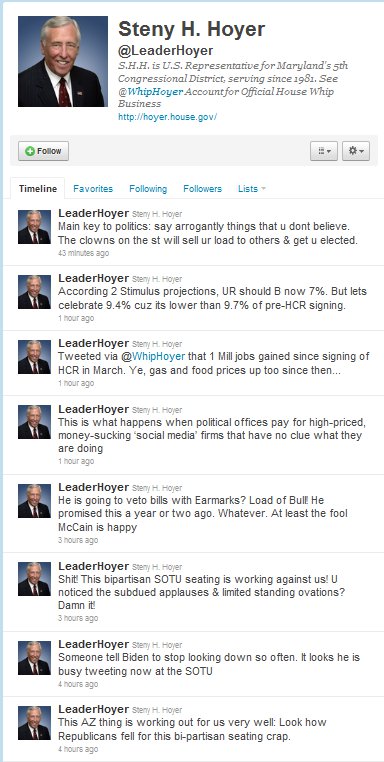Congressman Steny Hoyer Twitter impersonation attack

The twitter account LeaderHoyer, as recently as a few hours ago linked to by the official congressional web site of Maryland Congressman Steny Hoyer as his Twitter account, started expressing some unusually caustic views during the President’s State of the Union Address.
The tweets are obviously not Congressman Hoyer, however the account was likely not "hacked" as a few on Twitter have speculated. The LeaderHoyer account was definitely that of Congressman Steny Hoyer at one time, for example here is how it appeared on July 7th of last year:
But comparing the LeaderHoyer account now with its appearance last year, there are a number of inconsistencies. Last year the account showed as “Verified”, Twitter’s method of stating the authenticity of famous peoples' accounts, now it does not. The follower account tonight appears as 50, last year he had some 2,000+ followers. Finally, the account LeaderHoyer shows a creation date of January 14th, 2011, while the congressman has been on Twitter since the early part of 2009.
So What Happened?
Congressman Hoyer was recently reappointed to the role of House Minority Whip, leaving the role he had from 2007 to 2011 of House Majority Leader. Likely as a result of this, he modified the name of his twitter account from LeaderHoyer to WhipHoyer, an account that is verified, shows tweets you would expect from a congressman’s account, and has 5,734 followers. When the LeaderHoyer account was abandoned, it became available as a Twitter account name someone could sign up for, and in a display of patient planning a prankster signed up for the account on January 14th, and then waited for the 25th when Hoyer’s account would get maximum exposure (many constituents look at their congress member’s online communications to see their statement following the President’s speech) to start tweeting.
The congressman’s web site probably had an old link under the twitter icon, part of a bank of social media links in the right column of the official web site that disappeared later in the evening. Ostensibly that was the result of someone on the congressman's staff, or someone responsible for the web site, becoming aware of the link to the now rogue twitter account.
The whole exercise is a lesson in carefully planning and coordinating social media changes, as even the prankster not so subtly expressed in a tweet: "This is what happens when political offices pay for high-priced, money-sucking ‘social media’ firms that have no clue what they are doing." If the person perpetuating the hoax had posted tweets that were less ludicrous, the updates may have passed for those of the congressman for a while. For a politician, controlling communications with constituents is paramount.
But Twitter might consider a change here as well. Obviously accounts that are verified, but change names making what was once a verified account name available during user registration, are more of a target for people wishing to impersonate a well known person. Perhaps Twitter should lock those original names after a name change for a longer period of time, since they went through the Twitter verification program.
The timing of the attack is reminiscent of last year's mass defacement of congressional web sites following the State of the Union address by the Brazilian defacement team the Red Eye Crew.
